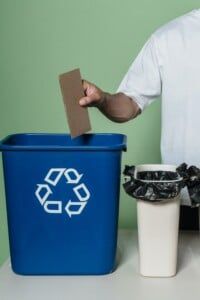6 Tips For More Sustainable Office Changes

Many people are familiar with the term “green office,” but not everyone knows what it means. Green offices are becoming more popular, as many companies take steps to be environmentally conscious and reduce their carbon footprint. There are plenty of changes that can be made in an office environment to make it more sustainable.
Do You Really Need It Printed?
Don’t print paper when you don’t have to. Don’t actually need something printed? Ask yourself if it’s even necessary at all. You can save a lot of paper and money by using electronic documents and digital files instead of printing everything out. If you must print, make sure that your printer is set for double-sided prints whenever possible. This will cut down on the amount of ink or toner needed, saving both time and resources in office supplies too.
Declutter
Get rid of old stuff that isn’t being used anymore before moving into a new office space. A simple way to reduce waste in the office is by getting rid of anything not currently being used within the company. Whether it means outdated equipment or unused furniture, it’s vital to get rid of all the clutter before you move into a new, smaller office space. This will reduce your overall waste output and make sure that everything is in good working condition for when you actually need it. Any old equipment or furniture, sell it and put the money back into your business.
Carpooling
Encourage employees to carpool or use public transportation whenever possible. Suppose every employee took part in carpools and used public transit instead of driving by themselves. In that case, they could cut down on carbon emissions from their own personal vehicles and decrease traffic congestion around the area. It’ll be a win-win situation.
Eco-friendly Cleaning Supplies
Use eco-friendly cleaning supplies throughout your whole business, including housekeeping services. You should have green products readily available in work areas and supply them with enough materials so that office cleaning services can use them as well. This will help ensure that you’re not generating any toxic fumes and chemicals throughout the office space.
Recycle Bins
Make recycling bins easily accessible and encourage employees to recycle items like paper, plastic bags, old clothing, or food scraps. You might think your company is small enough where it won’t produce much waste. However, chances are that a lot of recyclable materials are still going into landfills instead of being recycled properly. It doesn’t take long before even a small amount turns into tons of garbage that need to be stored somewhere for years on end if necessary. The best thing about recycling in an eco-friendly workplace is how easy it is to accomplish. Just place some clearly marked containers near the area where people tend to congregate, and you’re all set.
Paper Towels
Encourage employees to use fewer paper towels in the restroom. It seems like a good idea at first glance. Why not just provide people with more paper towels? However, this actually doesn’t do much for the environment because it means that they’ll be using up more of them instead of reusing one towel over and over again. This is definitely something where small changes can make a big difference.
Every office should implement some changes that make it a little greener each day. Even if it’s as small as replacing your regular air filters with air filter media material . This will help the environment and your bottom line because sustainable companies tend to perform better financially than those who don’t focus on environmental issues. Implementing these green practices can also improve morale among employees, which makes everyone happier about going to work each day.


